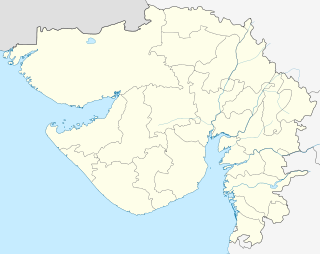- Dutch Suratte
-
Dutch Suratte
SuratteDutch colony ← 
1616–1795  →
→

Flag Coat of arms Capital Suratte Language(s) Dutch Political structure Colony Director - 1640-1644 Paulus Croock - 1691 Hendrik van Rheede - 1729-1740 Pieter Phoonsen Historical era Imperialism - Establishment of a trading post at Suratte 1616 - Kew Letters 1795 Suratte or Soeratte was a famous trading city on the north coast of what is now India, in the modern state of Gujarat, lying on the river Tapti. The city, now known as Surat, became a directorate of the Dutch East India Company in 1616. The British had established a factory in the Suratte in 1609 or 1612, after delivering a blow to the Portuguese.[1] It is part of what is today known as Dutch India.
Contents
History
Pieter van den Broecke established a Dutch trading post in Suratte in 1616, after previous efforts had failed in the years before. The Dutch East India Company was compelled to form this post after the sultan of Aceh no logner allowed them to buy cheap cotton on the local market.
By 1759, the Dutch East India Company's trade had fallen substantially. Trade had largely moved to British Bombay, with Suratte playing only a subordinate role. Due to the Kew Letters Dutch Suratte was relinquished to the British in 1795.
Trading posts
Settlement Type Established Disestablished Comments Suratte Factory 1616 1795 Founded by Pieter van den Broecke in 1616. After the British took the city of Suratte from the Mughal Empire in 1759, the trading post's role diminished. Eventually relinquished to the British in the Kew Letters. Ahmadabad Factory 1617 1744 Important trading port. The Dutch East India Company office was founded in 1617 and eventually abandoned in 1744. Agra Factory 1621 1720 Capital of the Mughal Empire. Due to the remote location of six weeks travel from Suratte, the trading post was almost never visited by inspectors of the Dutch East India Company. Private trading (forbidden by the Dutch East India Company) and corruption made traders here rich men. Cambay Factory 1617 1643 Rather unsuccessful post due to the inability of ships to dock at the port at low tide. After problems with local merchants closed in 1643. See also
- Dutch Malabar
- Dutch Ceylon
- Dutch Coromandel
- Dutch Bengal
- François Caron
- Mattheus de Haan
- Hubert Hugo
- Hendrik van Rheede
- Willem Verstegen
- Hendrick Zwaardecroon
References
External links
- http://www.nationaalarchief.nl/amh/detail.aspx?page=dafb&lang=en&id=5336
- http://www.vocsite.nl/geschiedenis/handelsposten/suratte.html
- http://www.swaen.com/antique-map-of.php?id=1214
- http://www.voc-kenniscentrum.nl/prod-suiker.html
Dutch Empire Colonies and trading posts of the Dutch East India Company (1602-1798) GovernoratesAmbon · Banda · Batavia · Cape Colony · Ceylon · Coromandel · Formosa · Northeast coast of Java · Makassar · Malacca · MoluccasDirectoratesCommandmentsResidenciesSettlements with an opperhoofdColonies and trading posts of the Dutch West India Company (1621-1792) Colonies in the AmericasAcadia · Berbice† · Cayenne · Curaçao and Dependencies · Demerara · Essequibo · Brazil · New Netherland · Pomeroon · Sint Eustatius and Dependencies · Suriname‡ · Tobago · Virgin IslandsTrading posts in Africa† Governed by the Society of Berbice · ‡ Governed by the Society of Suriname Settlements of the Noordsche Compagnie (1614-1642) SettlementsColonies of the Kingdom of the Netherlands (1815-1962) Until 1825Until 1853Until 1872Until 1945Until 1954Until 1962† Became constituent countries of the Kingdom of the Netherlands; Suriname gained full independence in 1975, Curaçao and Dependencies was renamed to the Netherlands Antilles, which was eventually dissolved in 2010. Kingdom of the Netherlands (1954-Present) Constituent countriesPublic bodies of the NetherlandsCategories:- Former countries in South Asia
- Former Dutch colonies
- States and territories established in 1616
- States and territories disestablished in 1795
- Dutch India
- Dutch East India Company
- History of Gujarat
Wikimedia Foundation. 2010.

